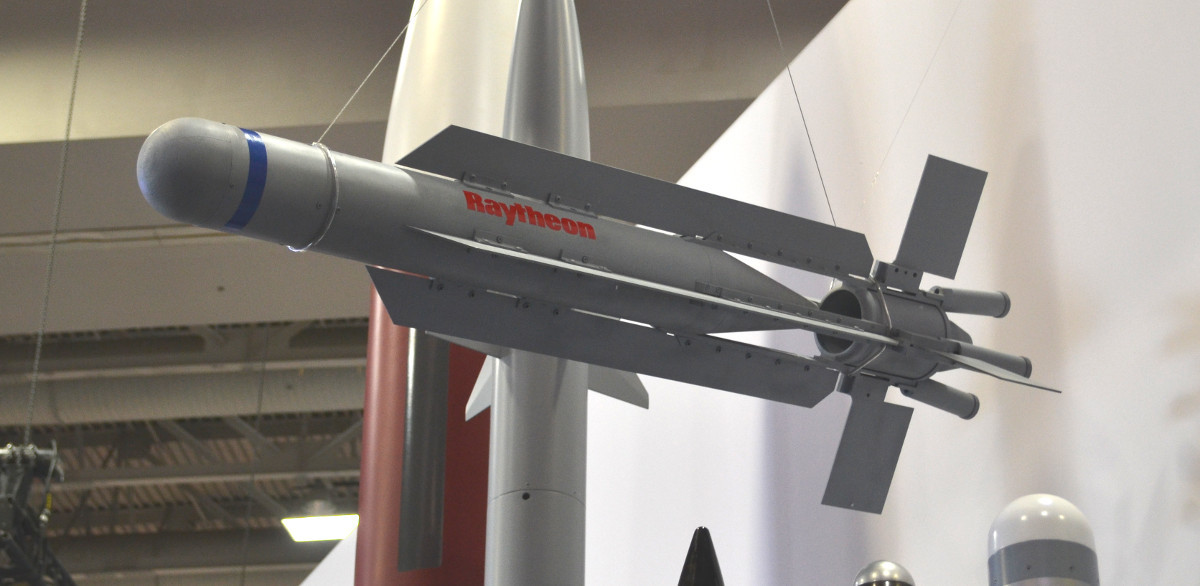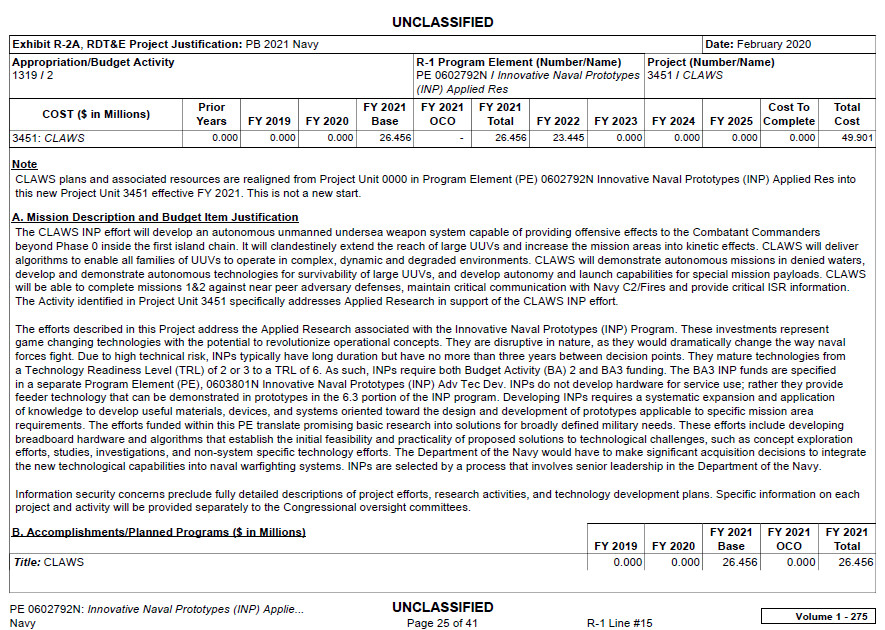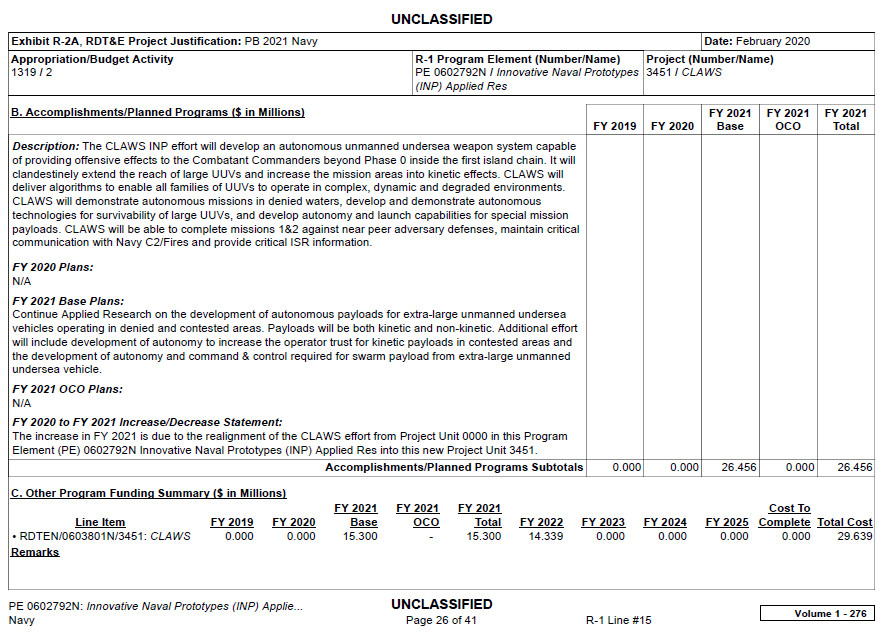The U.S. Navy has handed a contract to Raytheon for versions of its Coyote small unmanned aerial vehicle configured as loitering munitions, also known as “suicide drones.” The service says that it specifically wants them to support the development of unmanned surface and underwater vehicles as platforms to launch drone swarms, which could offer a slate of game-changing capabilities.
The Pentagon announced the deal, valued at up to almost $33 million if all the options were to be exercised, in its daily contracting notice on Feb. 26, 2021. The announcement said that the contract, which the Office of Naval Research (ONR) awarded to Raytheon, was for “Coyote Block 3 (CB3) Autonomous Strike” drones to support work on “Autonomous Swarm/Strike – Loitering Munitions.”
This is “a rapid capability effort to achieve operational launch capability from unmanned surface vessels (USVs) and an unmanned underwater vessel (UUV). The intended concept of operations (CONOP) and tactics, techniques and procedures (TTPs) are to provide intelligence, surveillance and reconnaissance (ISR) and precision strike capability from maritime platforms,” the contracting notice added. “Additionally, the High Volume Long Range Precision Strike (HVLRPS) from USVs and Fires (HVLRPF) from UUVs demonstrations will leverage prior efforts including the Innovative Naval Prototype (INP) and progress on the Mobile Precision Attack Vehicle (MoPAV).”
It’s not clear from Raytheon’s website whether the Block 3 Coyote is based on the design of the Block 1 or Block 2 version of that drone. Advanced Ceramic Research first flew the initial Coyote design, which is tube-launched and features two sets of pop-out wings, as well as a pop-up v-tail, in 2007. The design passed between a number of companies before finally ending up in Raytheon’s portfolio.

In 2017, Raytheon announced it was working on a new Block 2 version. In 2018, the U.S. Army announced it was buying these versions of Coyote as counter-drone interceptors. Later that year, it emerged that this variant, while still tube-launched, was a substantially different design with a more missile-like configuration.

The original variant had been marketed primarily as a small, low-cost intelligence, surveillance, and reconnaissance (ISR) platform. However, Raytheon has said in the past that both Block 1 and Block 2 Coyotes could be configured as a loitering munition, among other roles. A loitering munition is a type of weapon that occupies a space in between traditional missiles and other kinds of armed drones.
Typically, loitering munitions, which Israel pioneered and continues to a be leader in the design and manufacture of, are equipped with some form of man-in-the-loop control system. This allows an operator to “see” what the drone sees, right up until the moment of impact, allowing them to make fine adjustments in the terminal phase of flight. This, in turn, improves the overall accuracy of the weapon, even against moving targets. It also adds an additional margin of safety in that attacks can be aborted almost at the last second should circumstances change, such as the sudden appearance of innocent bystanders in the target area. Many loitering munitions can also be recovered for refurbishment and reuse if they do not engage a threat during their flight.
Autonomous swarming technology, including artificial intelligence-driven flight and targeting capabilities, are becoming increasingly popular additions to loitering munitions, as well. This kind of swarm can more rapidly search for and then engage multiple targets, either automatically or with human approval, across a large area. It’s important to note that ONR has already conducted demonstrations involving Block 1 Coyotes operating in swarms as part of its Low-Cost UAV Swarming Technology program, or LOCUST.

The Navy’s interest in loitering munitions is hardly surprising, both for its own use or in support of U.S. Marine Corps requirements. Both services, as well as other elements of the U.S. military, are pursuing multiple programs in this same general vein. What is much more notable about this particular contract is the desire to rapidly develop an operational capability to deploy swarms of loitering munitions from both unmanned boats and submarines.
There is extremely limited information readily available about the HVLRPS and HVLRPF programs. The Marine Corps’ Program Executive Office-Land Systems’ 2020 Advanced Technology Involvement Plan (ATIP) simply mentions USV-based HVLRPS as an ONR program that it is supporting. There is no mention in that plan of the UUV-based HVLRPF effort.
The same section of that document does include two LOCUST-related projects the Marines are working on together with ONR, one to integrate swarming drones with “expeditionary systems” and another regarding the development of a “LOCUST Expeditionary Launch Module.” There are also a pair of ONR-led efforts included that are associated with a “Super Swarm” program, one of which is also described as an INP, or Innovative Naval Prototype, a category of programs that includes various Navy advanced research and development efforts. There is equally limited information about that project, which may actually be a group of related projects. An edition of Future Force, an official ONR magazine, that was published last year said that recent “experimentation efforts” in support of Navy and Marine Corps requirements had included “Close-in Covert Autonomous Disposable Aircraft super swarm experimentation.”
“This record-setting effort simultaneously launched 1,000 unmanned aerial vehicles out of a C-130 and demonstrated behaviors critical to future super swarm employment,” this issue of Future Force said, but did not specify what type of drones were used in this test. “Data from the experiment will drive performance and effectiveness models and design trade-studies. Manufacturing data will inform efforts for onshore unmanned aerial system manufacturing.”
That sounds similar in some respects to tests of the Perdix micro drone, a project led that the Pentagon’s Strategic Capabilities Office led, between 2014 and 2016. One particular test in 2016 saw U.S. Navy F/A-18 Hornet fighter jets deploy a total of 100 of these unmanned aircraft in flight from underwing dispensers.

It’s also interesting to note that in the Navy’s 2021 Fiscal Year budget request, the service announced plans to close out a specific portion of the line item for INP Applied Research covering “Unmanned and Autonomous Systems” and shift those resources into three new efforts. One of these was LOCUST, while another was the Medium Displacement Unmanned Surface Vehicle (MDUSV). MDUSV is an ONR-led follow-on from the Defense Advanced Research Projects Agency’s Sea Hunter drone boat, programs you can read about in more detail in these past War Zone pieces. The descriptions of the plans for both LOCUST and MDUSV in the 2021 Fiscal Year as outlined in the Navy’s budget documents do not mention anything related specifically to loitering munitions, or swarms thereof.

The third line of effort the Navy planned to break out of the larger “Unmanned and Autonomous Systems” funding line is called CLAWS, but no definition is given for what that acronym means. However, the plan for work on this program in the 2021 Fiscal Year is described as follows:
Continue Applied Research on the development of autonomous payloads for extra-large unmanned undersea vehicles operating in denied and contested areas. Payloads will be both kinetic and non-kinetic. Additional effort will include development of autonomy to increase the operator trust for kinetic payloads in contested areas and the development of autonomy and command & control required for swarm payload from extra-large unmanned undersea vehicle.


In 2019, the Navy selected Boeing’s Orca drone submarine, which you can read about more in this past War Zone piece, as the winning design for its Extra-Large Unmanned Undersea Vehicle (XLUUV) program. All of this sounds exactly like work described in the contracting announcement from last week about ONR buying Block 3 Coyotes from Raytheon and the HVLRPF program specifically.

Beyond the work the Navy has already done with LOCUST, it’s worth pointing out that the service has already invested heavily in submarine-launched drone capabilities, especially in relation to its four high-specialized Ohio class guided missile submarines, or SSGNs. These boats, which you can read about in more depth in this past War Zone feature, are multi-purpose platforms with robust intelligence-gathering and command and control capabilities.
As for the exact concepts of operation and tactics, techniques, and procedures the Navy is envisioning around the HVLRPS and HVLRPF projects, while we don’t know what they might be exactly, the potentially game-changing capabilities they might offer are clear. Swarms, in general, inherently have the ability to confuse, disorient, and overwhelm opponents, especially enemy air defenses. This, in turn, can make it difficult for a hostile force to prioritize threats and respond effectively, potentially upending their plans and forcing them to divert critical resources away from their main lines of effort.
Swarms of loitering munitions could be just as effective in a maritime context as an overland one, too. Even if individual drones might not be able to outright destroy larger warships, they could still be used to target critical systems, such as radars or communications arrays, to produce a mission kill. That could put those vessels out of commission for a significant period of time while necessary repairs are conducted.
With all this in mind, it’s not hard to see how drone boats and submarines, lines of effort the Navy is also actively working on, potentially operating in swarms themselves, could be an even more capable combination. For example, UUVs, in particular, could be able to more readily ingress into a denied area without being detected and execute strikes on critical assets an opponent otherwise believes to be effectively off-limits to a hostile force. Even if those strikes fail in their immediate objective, they could easily force the enemy to redirect valuable forces away from the front lines in response.

“The CLAWS INP effort will develop an autonomous unmanned undersea weapon system capable of providing offensive effects to the Combatant Commanders beyond Phase 0 inside the first island chain,” the Navy’s 2021 Fiscal Year Budget request said regarding that program. “It will clandestinely extend the reach of large UUVs and increase the mission areas into kinetic effects.”
The “first island chain” is a zone of the Pacific defined by the boundary formed by the first line of major archipelagos out from mainland East Asia. It is a region of immense strategic importance, especially to China. It is an area that also includes the hotly disputed South China Sea and the Taiwan Strait, among other bodies of water where the Chinese People’s Liberation Army (PLA) can bring extensive anti-access and area denial capabilities to bear.

Drone boats loaded with swarms of loitering munitions could be a very capable additional line of defense against enemy swarms of small boats, including unmanned explosive-laden watercraft. Given that the Army is already acquiring Coyotes as a way to knock down small unmanned threats, they could serve as part of a multi-layered defensive shield against hostile drone swarms, too, a very real emerging threat.
A swarm might not necessarily have to just be made up of loitering munitions, either. Coyotes, or other small drones, carrying ISR, electronic warfare, or other payloads, could also be networked together, providing different types of functionality to make it easier to find threats and engage them in the most optimal way.
It’s worth noting that the Navy has already been hard at work at developing and fielding components of a secretive networked electronic warfare “ecosystem” called the Netted Emulation of Multi-Element Signature against Integrated Sensors, or NEMESIS. This effort is centered on a ‘system of systems’ approach to electronic warfare that will link together manned and unmanned aircraft, including future drones swarms, as well as ships, and submarines. The main goals of this program, which you read more about in detail in this past War Zone feature, are to create phantom fleets to disrupt opponents’ decision-making cycles and otherwise employ electronic warfare capabilities in a cooperative fashion. Swarms of electronic warfare-enabled and decoy drones are a critical part of this ecosystem. Being able to push them forward into contested territory for launch via unmanned underwater vehicle or drone ship would be a critical piece of this evolving puzzle.
With this latest contract to Raytheon, as well as all of these other at least tangentially related programs, the Navy has made clear that it sees its future operations as being full of swarms that expand the capabilities of its surface and underwater fleets, both at sea and over the shore.
Contact the author: joe@thedrive.com
